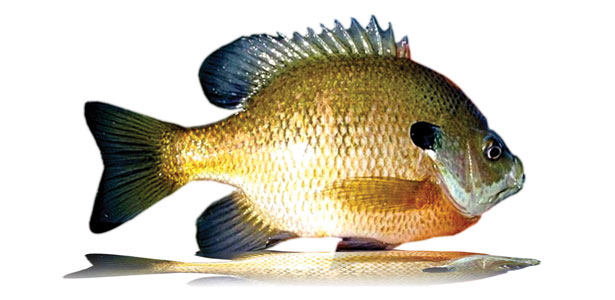
The Bluegill Sunfish (Lepomis macrochirus) is a freshwater fish specie sometimes referred to by Americans as “bream”. It is a member of the sunfish family and is native to a wide area of North America and was imported into southern Africa as a fodder fish for bass. It is renowned as an excellent table fish in the US but in South Africa its main purpose is bass food. They breed prolifically and are easy to catch. The Bluegill has the typical tropical sunfish body shape with its most notable feature the blue or black "ear" which is actually an extension of the gill cover, called the “opercular” flap. Its name however originates from the bright blue edging visible on its gill rakes. The bluegill grows to a maximum overall length of approximately 40 cm (16 in).
The Bluegill is a fun fish to catch on light tackle and can be caught on small soft plastic grubs, inline spinners, small spinner baits and small crank and jerk baits. Bluegill love structure and will be hanging around it for most of their lives. They are most commonly found in Kwazulu Natal and the Cape Province including some dams in Zimbabwe.
The favoured habitat of the Bluegill includes quiet, weedy waters where they can hide and feed. They inhabit lakes and ponds, slow-flowing rivers and streams with sand, mud or gravel bottoms near aquatic vegetation. Because of its willingness to take a variety of artificial lures during the entire year, its fighting ability when hooked and its excellent food qualities, it is a popular target for light tackle enthusiasts – indeed many anglers rank the bluegill as the most delicious of all freshwater fish to eat, particularly if you manage to catch fair size ones. They are very aggressive and often attack big lures as the fish in the photo (below?) that was caught close to Cape Town.
It is interesting to note that they can get quite large, with world record at a whopping 4 pounds, 12 ounces, caught in Ketona Lake, Alabama in 1950. On light tackle a big Bluegill can give you a fantastic fight and there are many anglers that target them as a species. Most bass anglers know how a Bluegill looks, but have not studied them to understand their behaviour and how we need to fish imitations of them to attract the attentions of trophy bass. This article is aimed at providing a deeper insight into the Bluegill as a bass prey fish specie.
Description
Bluegills have small mouths and oval-shaped, almost rounded, bodies. Always black, the flexible ear flap is small in juveniles, longer in adults. The body colouration is highly variable depending on size, sex, spawning, water colour, bottom type and amount of cover. Generally they have an olive green back similar to what bass anglers will call “pumpkin seed”. The underside of the gill area is blue for most of the year, and the breast becomes bright orange during spawning season. Females are generally lighter coloured than males. The distinctive characteristics or trigger points we want to imitate to attract bass are the prominent black spot on the rear edge of the gill-cover, the blue gills and the orange breast.
Juveniles and non breeding adults are light olive to gray on the back and sides with several evenly spaced, darker vertical bands. For trophy bass however, we want to imitate the male Bluegill in its breeding colours with its trigger points highlighted.
Big bass love to eat big Bluegill, but because of the body shape and the dorsal fin, bass always hit a bluegill from the front and swallows it head first. Quite a few local anglers have encountered big bass that have died or are still struggling with a big bluegill stuck in the throat. When standing on a boat the easiest way to identify bluegill in the shallows is the black ear flap that is clearly visible when looking from above. When Bluegill are not breeding they become schooling fish with schools consisting of 20–30 individuals.
Food Source
Young Bluegill eat mostly plankton. Adult Bluegill mostly eat insects, insect larvae and crustaceans. They will also eat vegetation, fish eggs, small fish and snails when they get the opportunity, but for most of the year this will not form the bulk of their diet. For the bass angler this means that Bluegill will feed and relate to structure like trees and vegetation where these food sources are readily available.
Size
Bluegill reach sizes up to 10 inches (254 mm) but as a bass baitfish imitation we concentrate on 4, 5 and 7 - inch sizes. Bluegills live for five to six years.
Habitat
Bluegills occur in large and small dams, and from small streams to large rivers, reservoirs, swamps, and especially popular bass dams such as Albert Falls. Bluegill are very often found near largemouth bass nests and is the “go to” baitfish to imitate in any dam they occur in during the spawning season. Bluegills are density dependent, meaning that as their numbers increase (within limits), their relative sizes decrease. It is therefore imperative to catch and remove smaller fish to avoid overpopulation, as is the case with bass where uncorrected overpopulation adversely affects the age-class structure and eventually takes the dam out of balance. Bluegills prefer the quiet, weedy waters where they can hide and feed. They also prefer any one of a sand, mud, or gravel bottom as long as it is near aquatic vegetation. The Bluegill, unlike many of our kurper species, can tolerate very low water temperatures and survive cold winters - in the US they are often caught under the ice. This is the major reason why they were stocked as a baitfish for bass in the southern part of South Africa where our kurper species struggle during the winter. Bluegill are not randomly distributed in a dam, but they rather concentrate into specific habitats, depending upon the season. In spring and summer they congregate in the shallows to spawn, become very aggressive, and are particularly easy to catch for both anglers and bass. You will easily spot the saucer shaped nests near shore because bluegill build their nests in shallow water very close to shore. Carefully search water from 2 to 6 feet deep and locate a spawning bed. Male bluegills guarding nests are easy prey for bass due to their spawning aggressiveness.
Bluegill spend their summer in deeper water and congregate along undercut banks and tend to favour old, fallen trees such as those found scattered all over Albert Falls Dam for example. They also favour any holes near the shoreline, roots of trees and other snags. The edge of lily pads or other aquatic vegetation is also a good place to find bluegill and their predators. Shoreline points that extend far out into the lake and drop off sharply often concentrate bluegill. A "hot spot" is an underwater ridge or ledge in 8 to 10 feet of water. Bluegill will set up under the rock. When you find this location also look for nearby brush and other possible cover in the water. It is obvious that Bluegill and bass like the same habitat and are often found in close proximity of each other, and when reading this article anglers who know Albert Falls will understand why bass are caught in certain areas.
Breeding Habits
Bluegills are well known for "bedding" in large groups, with their circular beds touching one another. Bedding occurs in water two to six feet deep over sand, shell or gravel, and often among plant roots when the bottom is soft. Spawning occurs from September to April with the peak in December and January, when water temperature rises to about 25°C. A female can lay 2,000 to 63,000 eggs, which hatch 30 to 35 hours after fertilization. The male Bluegill gets extremely aggressive during the spawn. This results in two things happening: firstly predation on the male is high and secondly the male is not a good parent. Very often there will be two females present in the spawn – a mimic and the true female – and the two females will stay behind and protect the eggs and young.
Recent Research Findings
The Bluegill is a food source for bass from the time they are born to the time they reach about 15 – 20 cm depending on the size of the bass in the dam. A big bass likes a big meal and a 5” Bluegill, due to his round shape, is a proper meal. They are often responsible for aggressive bass action as bass will feed on the small schools of Bluegill around points, drop-offs, standing timber and lay downs and the edges of the vegetation. During the summer months when the Bluegill spawns you are bound to find trophy bass close by. Look for any structure close to the spawning grounds.
The Bluegill has certain markings - the prominent black spot on the rear edge of the gill-cover, the blue gills and the orange breast - that act as a trigger for bass. A bass that sees the combinations of these triggers bouncing on the bottom, along a point or drop off, around would or vegetation will react aggressively. The trick is to enhance the trigger by bringing out the contrast in your imitation. A definite big bass method is to find standing timber and brush and fish the imitation with a jerking action through the structure and letting it bounce off the structure. The imitation bouncing off the structure duplicates the Bluegill feeding on insects and crustaceans living there.
Fishing a drop-off into deep water, especially if associated with a point, is another key area where you want to utilise a Bluegill imitation. When bass are aggressively feeding, a crankbait displaying the right trigger points worked from the swallows over the drop off will work very well. If the bass are not that aggressive or the crank bait bite stops, switch to a heavy Texas - rigged soft plastic imitation of a Bluegill and bounce it down the edge of the drop off and on the bottom in the deeper water.
Conclusions
Fish edges and points of vegetation, standing timber, lay downs and brush, points, rock and drop offs using Bluegill imitations. Keep your eyes open when moving through the shallows in summer and look for the tell tale nests. If you find them fish the closest structure. First fish the edges and then fish inside the structure with a Texas -rigged soft plastic Bluegill imitation.
Remember that when we are trying to imitate baitfish we have to move the lure as a baitfish will move. A baitfish will stand still and then move with a short darting action or swim around in a school or quickly take cover. A baitfish makes sudden movements so try and imitate that. A Bluegill will hide in the structure; quickly dart out to eat a water insect or other morsel and dart back where it came from.
A smaller bass is not very fussy, but if you want to trigger a big bite consistently, do everything you can to put the odds in your favour. Don’t only match the hatch with the bait you choose but also by the way you fish it and where you fish it.


 Visit us our
Visit us our